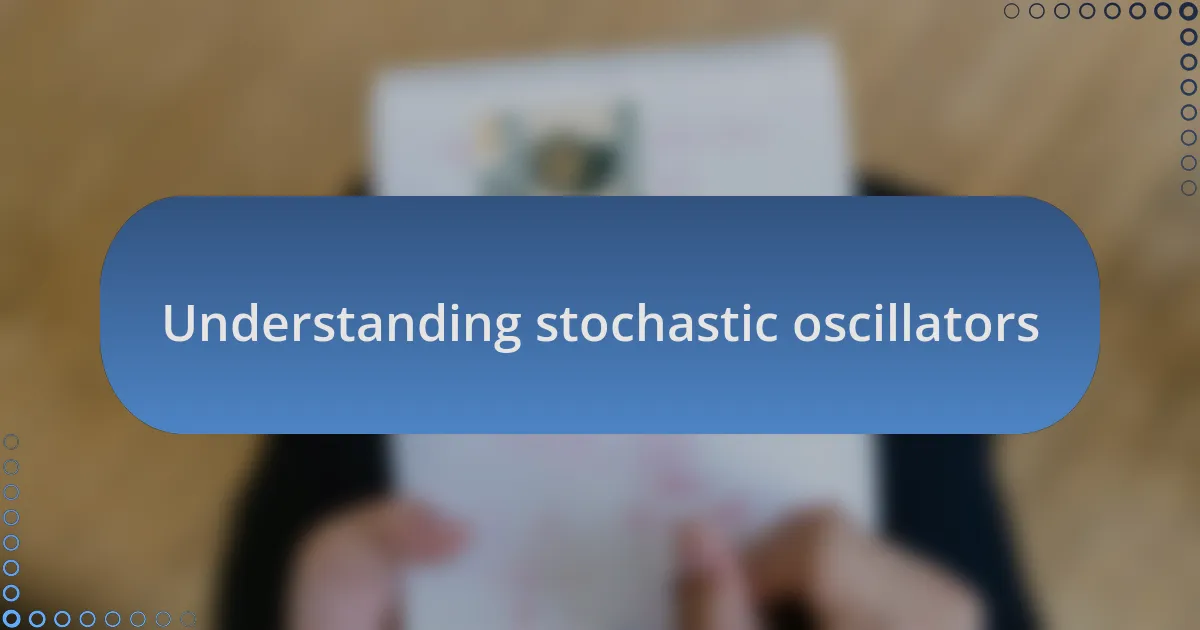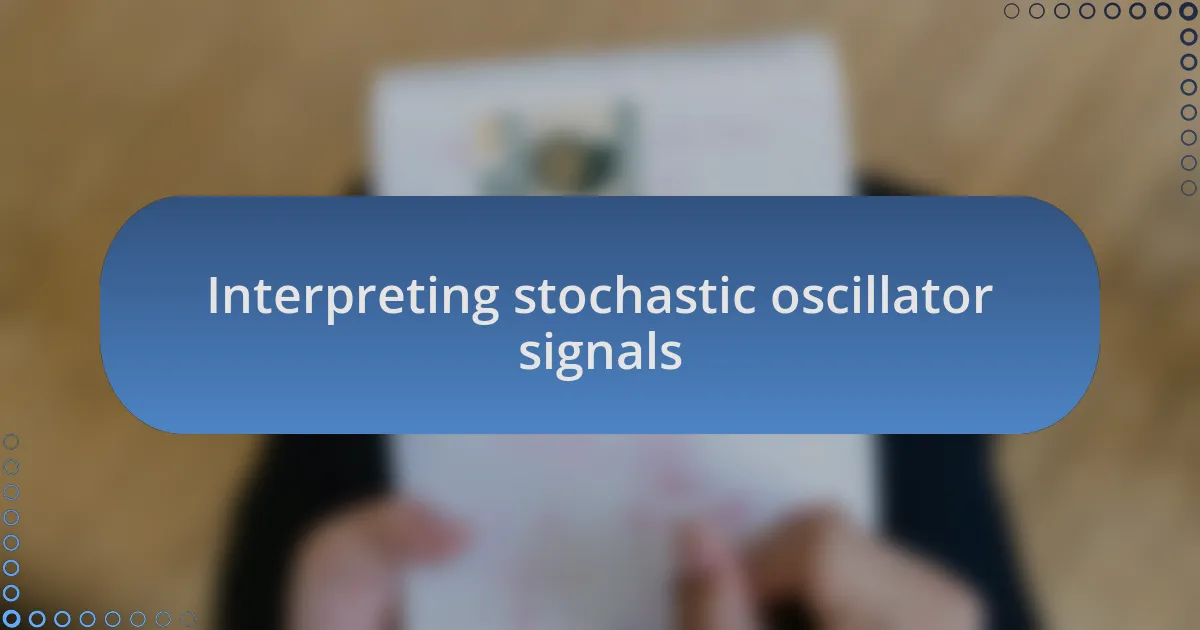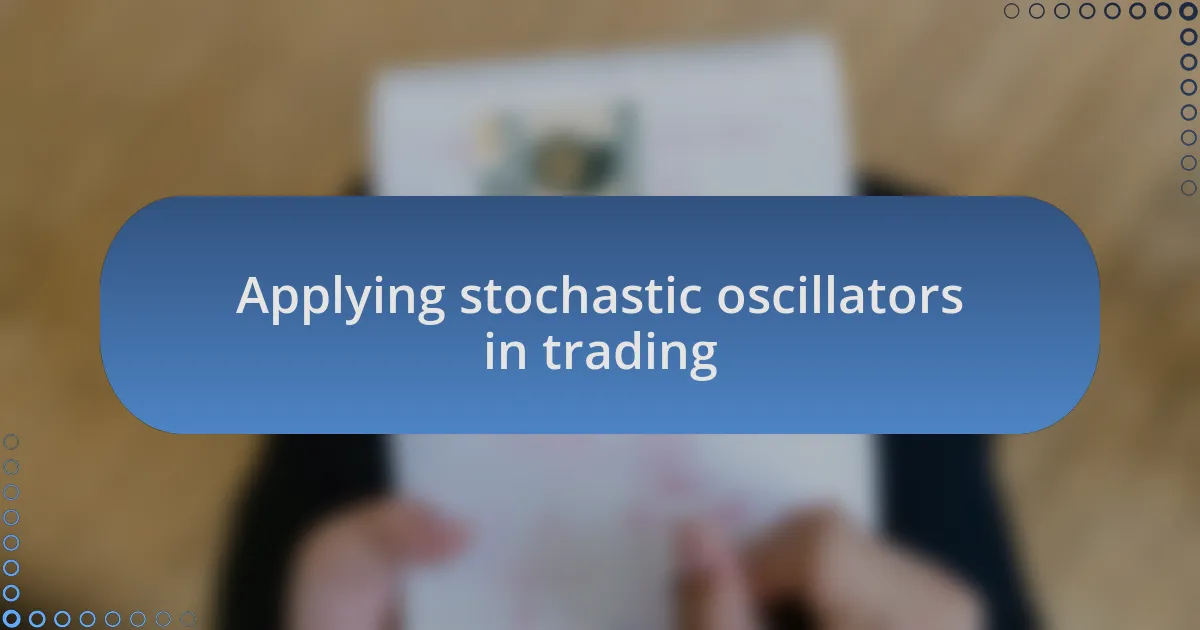Key takeaways:
- Stochastic oscillators indicate when assets are overbought (above 80) or oversold (below 20), helping traders optimize entry and exit points.
- The oscillator operates on a scale of 0 to 100, combining %K (current closing price) and %D (signal line) for trade signals and trend analysis.
- Divergences between price movements and the oscillator can signal potential market reversals, offering valuable insights for traders.
- Successful trading with stochastic oscillators requires context; integrating additional tools improves decision-making and risk management.

Understanding stochastic oscillators
Stochastic oscillators are powerful indicators that help traders gauge momentum in the market, particularly in the realm of cryptocurrencies. I remember when I first encountered this tool; it was like flipping a switch that illuminated the subtle shifts in market trends. Have you ever felt overwhelmed by price fluctuations? This is where the beauty of stochastic oscillators comes into play, providing clarity amid chaos.
What I find fascinating about stochastic oscillators is their ability to reflect when an asset is overbought or oversold. A reading above 80 typically signals overbought conditions, while below 20 suggests that an asset might be oversold. Can you imagine the advantage this offers? Knowing when to enter or exit a trade based on these levels can significantly enhance a trader’s strategy.
Additionally, the oscillator operates between a scale of 0 to 100, making it intuitive to interpret. I often observe its interaction with price movements, and I’ve noticed that divergences between the two can offer enlightening insights. Have you ever seen a price action rise while the oscillator falls? These moments can indicate potential market reversals, making them essential points to ponder when strategizing my trades.

How stochastic oscillators work
The stochastic oscillator operates by comparing an asset’s closing price to its price range over a specific period, often 14 days. I remember meticulously calculating these values back when I first started trading, and it became evident how this simple formula reveals underlying market momentum. Have you ever taken a moment to consider how this dynamic reflects market sentiment? It’s truly enlightening to see how the oscillator encapsulates traders’ psychology in numerical form.
What excites me about the stochastic oscillator is its dual components: %K and %D. The %K line represents the current closing price relative to the price range, while the %D line serves as a signal line, smoothing out the %K for easier interpretation. When I first grasped this concept, it was like putting on glasses that sharpened my focus on critical trade signals. Have you experienced the thrill of recognizing the moment one line crosses above the other? That’s often the signal for potential entry or exit points, illuminating the path forward.
Additionally, traders can adjust the period setting to suit their trading style, whether they favor short-term or long-term strategies. I recall experimenting with different settings and realizing how sensitive the oscillator could be in volatile markets. Does this adaptability make it easier to fit into various trading plans? I’d argue it does, as it allows traders to tailor their approach while staying attuned to price movements—an invaluable asset in the ever-changing landscape of cryptocurrencies.

Interpreting stochastic oscillator signals
Understanding how to interpret stochastic oscillator signals can transform your trading experience. For me, the first moment I understood overbought and oversold conditions was a game-changer. When the %K line rises above 80, it often signifies an overbought situation, implying that a price correction might be imminent. I remember feeling a mix of excitement and caution as I began to time my trades based on this indicator, keenly aware of both the potential for profit and the risk of a price pullback.
Then there’s the magic moment when the %K line dips below 20, indicating oversold conditions. I’ve seen markets bounce back from these levels, and there were times when I hesitated—should I buy now or wait? My experience has taught me that while oversold signals can lead to opportunities, some markets can remain oversold for a remarkable period. Reflecting on those instances, I realize the importance of combining these signals with other indicators to confirm my trading decisions.
Moreover, I’ve noticed that divergences between price and the stochastic oscillator can reveal powerful insights. When the price reaches a new high, but the oscillator does not, it signals potential weakness in the trend. I remember encountering this scenario during a particularly volatile market phase—it spurred me to rethink my positions. Have you ever spotted such a divergence and felt the adrenaline rush of a potential shift? Learning to look for these tells not only bolstered my analysis but also deepened my understanding of market dynamics.

Applying stochastic oscillators in trading
When applying stochastic oscillators in trading, timing becomes essential. I vividly recall a period when I relied solely on these indicators, eagerly waiting for the %K line to cross below 20. There was this thrilling moment when I decided to act on it, buying into a market I believed was due for a rebound. The adrenaline as I hit the buy button was palpable, and I felt ready to surf the waves of market sentiment.
However, I learned that blindly following these signals without context could be a rookie mistake. Once, I jumped into a trade after spotting an oversold condition, but the market continued to decline. It was frustrating, and I found myself questioning: what went wrong? This taught me that integrating additional tools and analysis helped to balance out the risks, providing a framework for more grounded and assured decisions.
Observation played a pivotal role in my success with stochastic oscillators. I’ve tracked situations where the %D line crossed over %K, creating what I call ‘the sweet spot’ for entry. This crossover moment clicked for me; it felt like a secret handshake among traders. I often wonder if others experience that same rush when they recognize these patterns. Embracing this instinct while combining it with solid data analysis has shaped my trading approach profoundly.